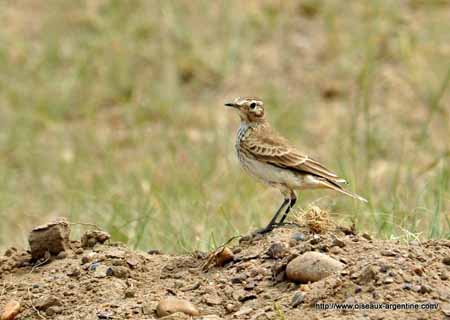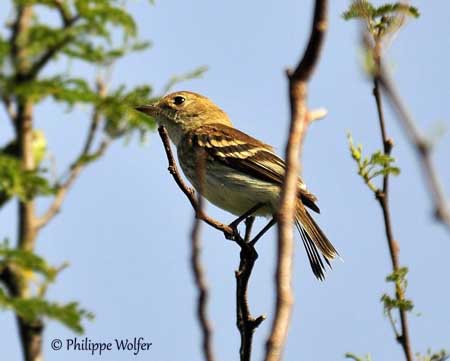
Text by Nicole Bouglouan
Photographers :
Didier Buysse
Vision d’Oiseaux
Marc Chrétien
MURINUS
Alfredo Colón
Puerto Rico Wildlife
Maxime Dechelle
LEPAPARRAZO
Jean Michel Fenerole
Photos d’Oiseaux du monde
Tom Grey
Tom Grey's Bird Pictures
Eduardo Andrés Jordan
MIS AVES – AVES DE ARGENTINA
René Lortie
http://rlortie.ca/
Tom Merigan
Tom Merigan’s Photo Galleries
Pete Moulton
Pete Moulton Photography
Philippe and Aline Wolfer
OISEAUX D'ARGENTINE
Sources:
HANDBOOK OF THE BIRDS OF THE WORLD Vol 9 - by Josep del Hoyo - Andrew Elliot - David Christie - Lynx Edicions - ISBN: 8487334695
A GUIDE TO THE BIRDS OF MEXICO AND NORTHERN CENTRAL AMERICA by Steve N. G. Howell, Sophie Webb - Oxford University Press - ISBN: 0198540124
A GUIDE TO THE BIRDS OF COLOMBIA by Steven L. Hilty and William L. Brown - Princeton University Press – ISBN 069108372X
BIRDS OF THE GREAT BASIN – by Fred A. Ryser - Univ of Nevada Pr -ISBN: 0874170796
TYRANNIDAE FAMILY
Tyrants-Flycatchers
Subfamily Fluvicolinae
The subfamily Fluvicolinae contains about 130 species and is the most widely varied group regarding the size, shape and foraging behaviour. We find two principal lineages Contopini and Fluvicolini.
The group Contopini includes forest and woodland species which hunt by sally-gleaning and are aerial hawkers. Their foraging areas are within the dark interior of the tall forest, but also at the open edges. The birds of this group show wide bill and long rictal bristles.
The group Fluvicolini is widely diversified. These birds are found in the dry open country south of Amazonia, and also in the temperate grassland of the southern Andes. Most of the species are associated with open country such as arid scrub and open woodland to grassland and barren areas. This group includes birds with peculiar plumage adaptation and body shape.
Group Contopini
The small upright-perching flycatchers of the genus Myiophobus frequent the humid forest, most of them in the subtropical zone of the Andes or in southern Venezuela.
The Bran-coloured Flycatcher (Myiophobus fasciatus) is common in tropical woodland underbrush from Costa Rica S to Argentina.
This is a typical Tyrannidae species which hunts by aerial hawking and sally-gleaning within the vegetation, often near the edges.

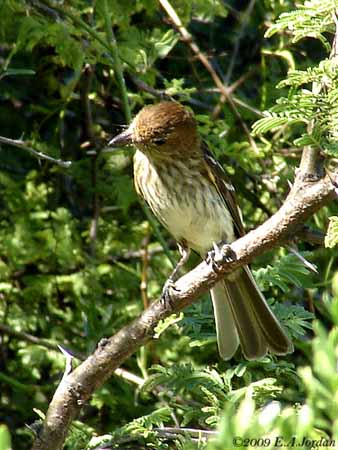
The members of the genus Myiobus exhibit very long rictal bristles, large eyes and a colourful crown patch like in Onychorhynchus. Both genera build hanging nests. However, all Myiobus species have a unique behaviour in Tyrannidae. They rarely remain on perch for more than 1-2 seconds, always moving nervously and fanning the tail. They hunt first by an explosive flight at a leaf to knock an insect off it, and then, by rapid aerial chase through the open understorey.
The single member of genus Terenotriccus, the Ruddy-tailed Flycatcher (Terenotriccus erythrurus) has long rictal bristles that may extend beyond the tip of the short, broad bill. It is often regarded as a miniature Myiobus, but it lacks the crown patch and forages by remaining perched upright for long periods before to perform flush-chasing, sallies or movements.
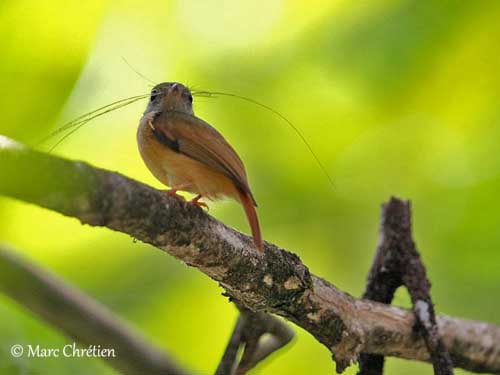
Ruddy-tailed Flycatcher - Terenotriccus erythrurus
With nest materials
The peculiar Cliff Flycatcher (Hirundinea ferrugina) has shorter tarsi and longer wings than usual in Tyrannidae, due to its aerial hawking behaviour. This species occurs in subtropical range and up to 1000-2500 metres of elevation on moist Andean slopes in a narrow band from coastal Venezuela to N Argentina. It forages along the edges of waterfalls, at forest openings and at small outcroppings.
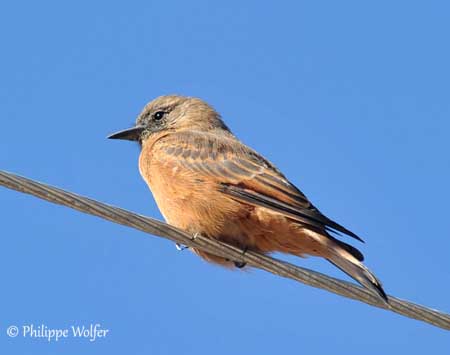
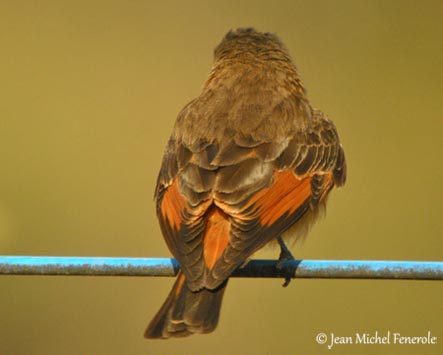
This species builds a cup-shaped nest on cliff ledges, and its unusual proportions with the short tarsi and the long, pointed wings, make it very similar to swallows (Hirundinidae).
The genus Mitrephanes is a perfect connexion between the previous montane forest species and the widespread radiation of pewees of the genus Contopus.
The Tufted Flycatcher (Mitrephanes phaeocercus) may sit on bare perches above the humid forest canopy for hours. It performs sallies into the open air near the moist vegetation and returns to the same perch.
This bird is a miniature pewee. It has a wonderful dawn song, a refrain of sweet, rapidly jumbled notes uttered from high, exposed perch.
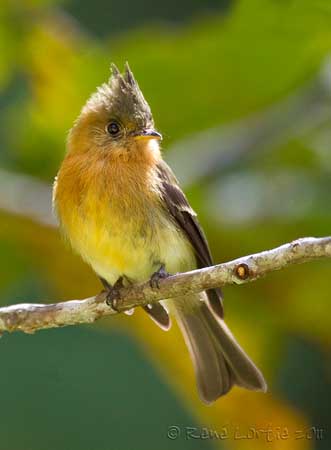
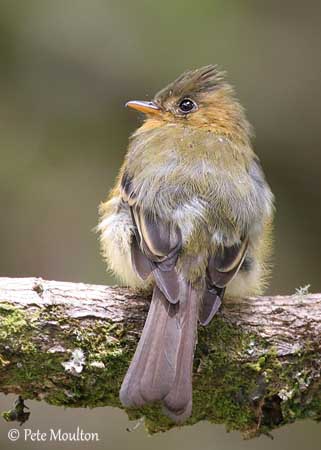
Several genera constitute the “Empidonax group” and are united by similar morphological internal criterions in syrinx.
Lothroticcus, Aphanotriccus, Xenotriccus, Cnemotriccus, Empidonax, Contopus and Sayornis are included in this group.
The members of the four first genera are small to medium-sized birds with large head and broad bill. They forage by upright-perching, aerial hawking and sally-gleaning at lower levels of scrubs, open woodlands and river-edge forest.
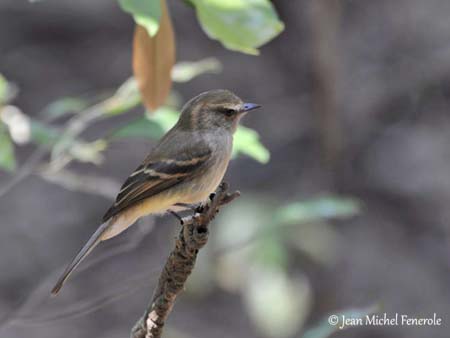
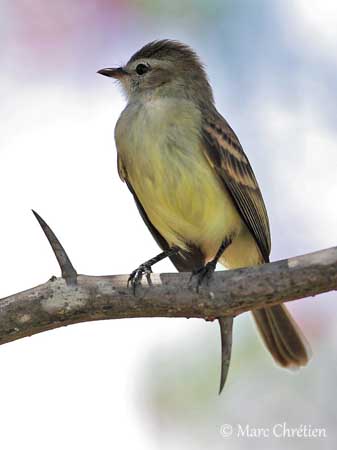
The Contopus pewees are found in Costa Rica, West Indies and S America. They are medium-sized to large flycatchers with long and wide bill and well developed rictal bristles, long wings and short tarsi. They forage by sitting for long periods on exposed perches, moving quickly the head from side to side, and performing acrobatic aerial manoeuvres after flying insects.
The Olive-sided Flycatcher (Contopus cooperi) is the largest of the genus and breeds in montane forest of spruce and fir in W North America.
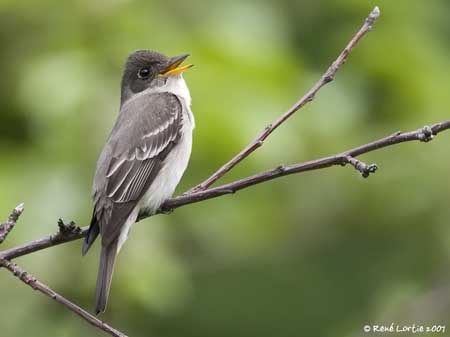
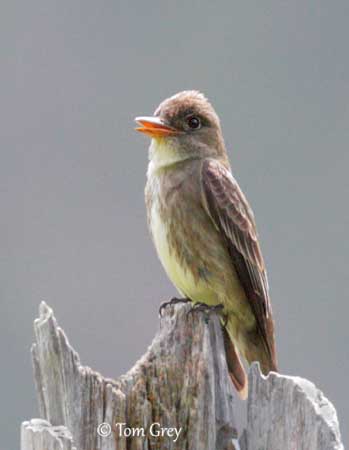
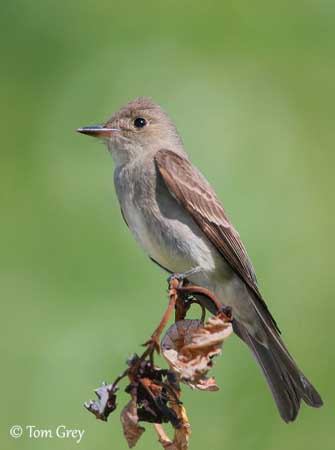
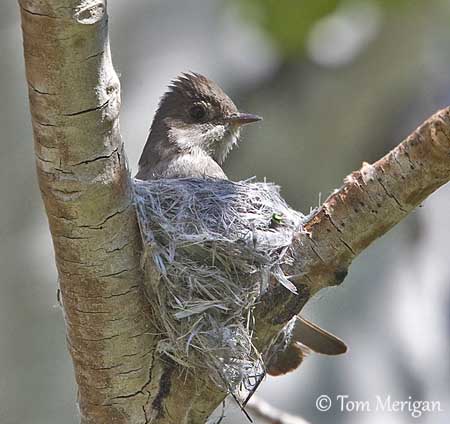
The members of the genus Empidonax show fairly similar structure and plumage pattern, but the differentiation occurs mainly through voice and behaviour. These birds are always difficult to identify.
The Willow Flycatcher (Empidonax traillii) and the Alder Flycatcher (Empidonax alnorum) utter distinctive songs across their ranges, either “fitz-bew” or “fee-bee-o”. Each bird sings only one and does not respond to song of the other type.
There also are differences in habitat, nesting habits and distribution between birds with almost similar plumage characteristics.
There is a similar example with the splitting of the Western Flycatcher into two species. They can be differentiated mainly by their primary advertising song, and they occur in quite different habitats on each side of the Cascade and Sierra Nevada mountain ranges.
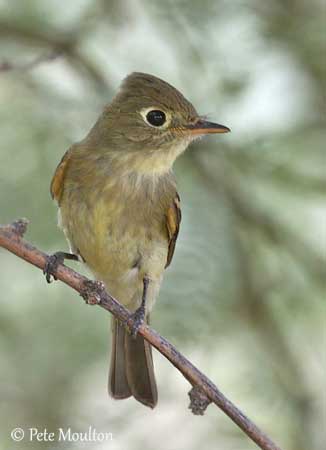
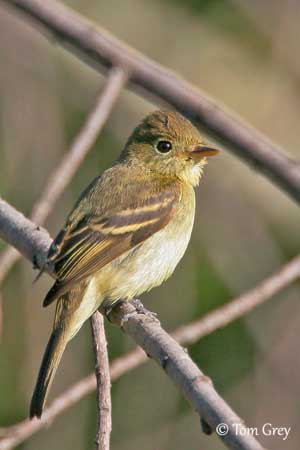
Numerous Empidonax species are widespread in North and Middle America. Some of them have more restricted range.
The Yellow-bellied Flycatcher (Empidonax flavirentris) breeds in eastern coniferous habitats, whereas the Hammond’s Flycatcher (Empidonax hammondi) occurs throughout western spruce-fir habitats from N Alaska S to Central Rockies.
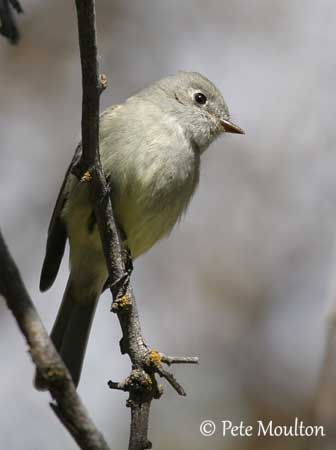
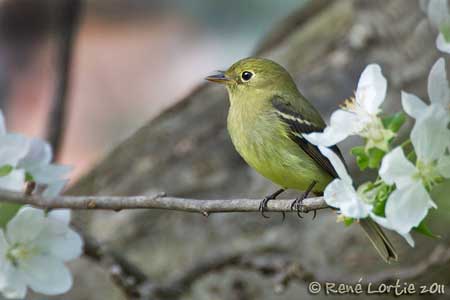
The genus Sayornis contains three species which breed in N America, although the Black Phoebe (Sayornis nigricans) breeds from California S through the Andes in N Argentina.
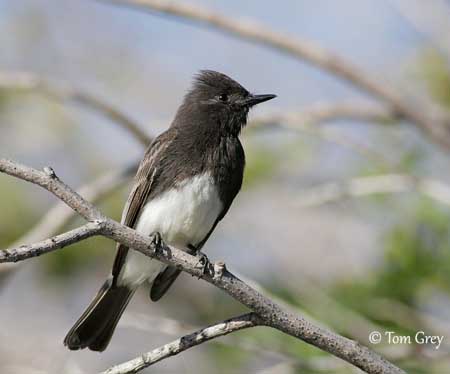
Sayornis nigricans
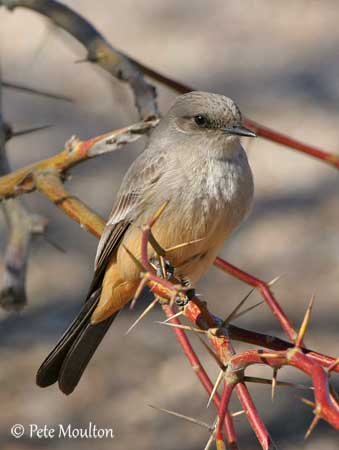
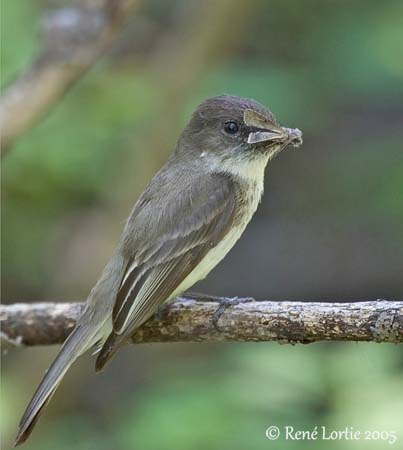
They represent a transitional genus between the group Contopini and the following large assemblage of ground and near-ground species in the large tribe Fluvicolini.
Group Fluvicolini
The most brightly coloured of the entire Tyrannidae family is the Vermilion Flycatcher (Pyrocephalus rubinus). This pretty bird has a wide range, from SW USA through most of Central America and S to N Patagonia. It is also present on Galapagos Islands where the birds have orange-red plumage. The species which occurs near Lima in Peru has sooty brown plumage.
The Vermilion Flycatcher male has bright red and black plumage, whereas the female is duller, greyish-brown above with more or less streaked underparts and sometimes yellow or pinkish lower belly.
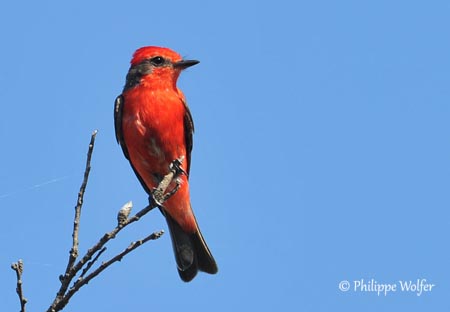

It forages in open areas, often near water, and performs frequent sallies to the ground. The male displays with the erect crest and fluffed plumage. It performs fluttering flight above the female. The nest is a loose open cup placed in fork in bush or tree.
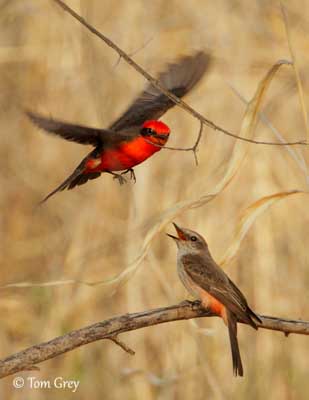
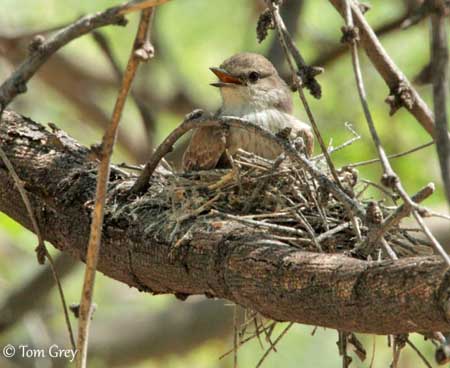
The other Fluvicolini species occur in fairly closely related genera, but with great diversity in body forms and foraging behaviour. Most of them frequent open country and forage mainly on the ground.
The two species of genus Lessonia are long-legged flycatchers, foraging on the ground in the wet grasslands and in marshy areas.
This genus is united with the previous Pyrocephalus, due to similar internal morphological characters in syrinx.
Lessonia has long, straight hind claw, probably used when perching on the wet marshy vegetation from which it sallies for preys.

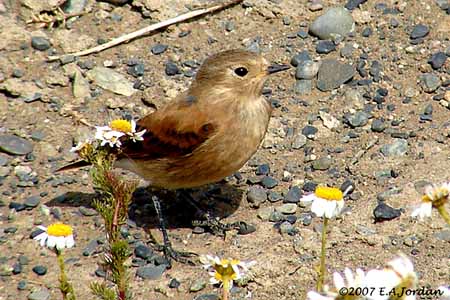
The long-legged Spectacled Tyrant (Hymenops perspicillatus) is very distinctive. It has large, fleshy yellow eye-ring and it is the only one in the family with so peculiar feature. The male has black plumage with large white wing patches. The bright yellow bill adds something special to this species. The female is duller with cryptic plumage, streaked brown above with paler underparts. This dull plumage provides good camouflage in the grassy habitats where they live and in the marshy areas where they breed.
The species occurs in Uruguay, Paraguay and N Argentina. It forages by aerial sallies or runs on the ground or on the floating vegetation.
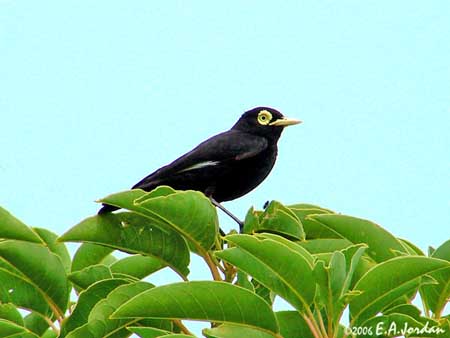
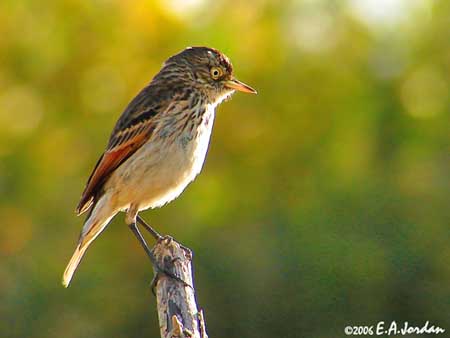
The white wing patches of the male are conspicuous in flight, end especially during the spectacular aerial courtship displays. The nest is a woven cup-shaped structure built between reeds, about a metre above the water in marshes.
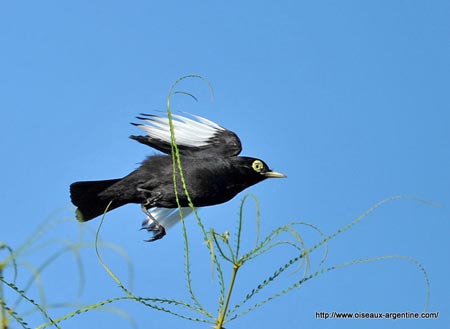
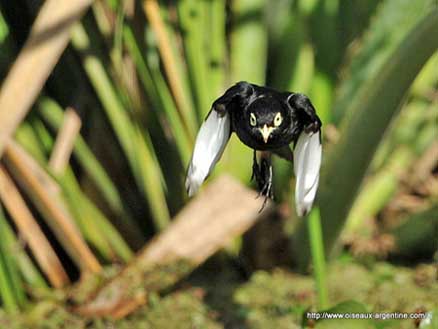
The black-tyrants of the genus Knipolegus are aerial hawkers, perching at the top of shrubs or small trees along open areas.
Most of them occur in southern Brazil and in Patagonia. Some species are present farther north along Orinoco and Amazon drainages.
In a few species, both sexes have similar plumage. This is the case of the Velvety Black-Tyrant (Knipolegus nigerrimus).
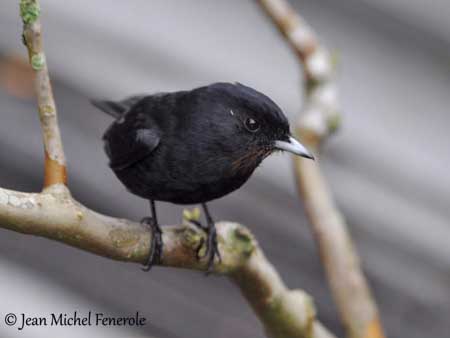
Velvety Black-Tyrant
Knipolegus nigerrimus
However, in Blue-billed Black-Tyrant (Knipolegus cyanirostris), the male has black plumage overall with faint white edges on underwing flight feathers, and bright red eyes. The female is rufous-brown above and has pale streaked brown underparts.
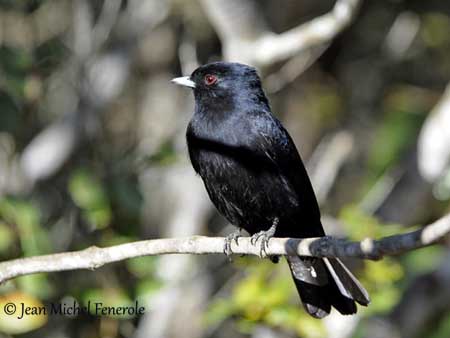
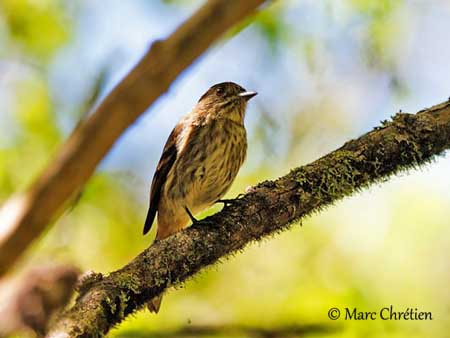
The genus Ochthoeca contains the chat-tyrants. These medium-sized birds represent an exclusively Andean radiation of Tyrannidae. They frequent several types of habitats at different elevation.
The largest chat-tyrants occur in misty treeless páramo and puna zones at high elevation, and in the arid western ridges.
This is the habitat of the Brown-backed Chat-tyrant (Ochthoeca fumicolor) and the White-browed Chat-tyrant (Ochthoeca leucophrys).
Slightly lower, just below the tree-line, in the brushy forest, we can find the four members of the Sylvicultrix group. They can be either dark sooty as the Crowned Chat-tyrant (Ochthoeca frontalis), or dark olive as the Yellow-bellied Chat-tyrant (Ochthoeca diadema). Both have contrasted, colourful loral spots.
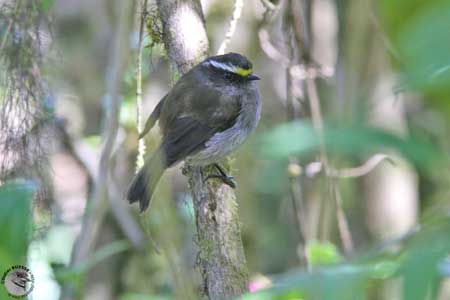
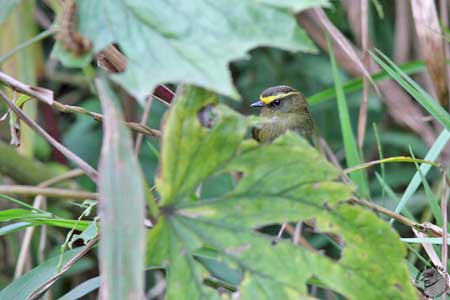
Farther down the slopes, we find the remaining two species, often seen perched at the edges of ravines and rocky waterfalls.
In the genus Tumbezia, the distinctive Tumbes Tyrant (Tumbezia salvini) is a lowland species, restricted to the arid Pacific coasts of Ecuador and N Peru.
The Patagonian Tyrant (Coloramphus parvirostris) inhabits the southern temperate forests of Chile and Argentina. It may perform seasonal movements.
The Drab Water-Tyrant (Ochthornis littoralis) is common at the edges of brushy rivers throughout the Amazonian lowlands. This species nests on clay ledges above the river during the low-level period.
The Yellow-browed Tyrant (Satrapa icterophrys) is an uncommon but conspicuous bird of brushy, open country south of the Amazon, and an austral migrant to the llanos of Venezuela.
It forages by aerial sallies from perches, often high in shrubs. It also makes sally-gleaning against leaves and often consumes fruits.
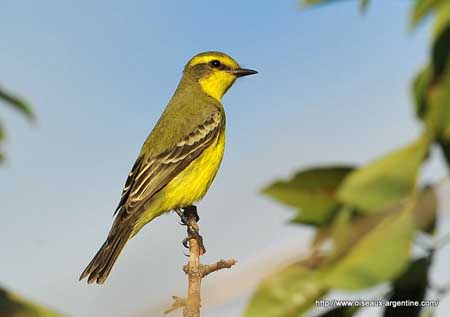
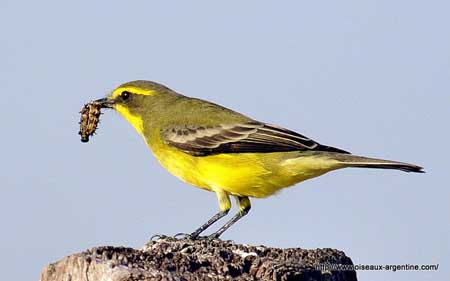
The three species of the genus Fluvicola are water-tyrants. They form a clade with the White-headed Marsh-tyrant (Arundinicola leucocephala) due to similar internal morphological features.
They are closely related to marsh and lakeside habitat types. Both genera build a large, globular nest made with grass and feathers, always with a side entrance as numerous Tyrannidae species. They are sexually dimorphic.
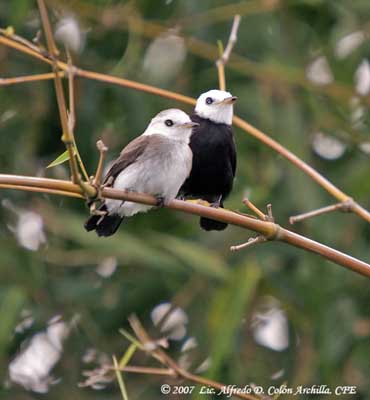
On the other hand, the water-tyrants show minimal dimorphism. They are mainly terrestrial and often perch on the ground or on floating vegetation from which they often sally for insects and spiders near the water surface.
The Black-backed Water-tyrant (Fluvicola albiventer) and the Pied Water-tyrant (Fluvicola pica) are almost identical in behaviour.
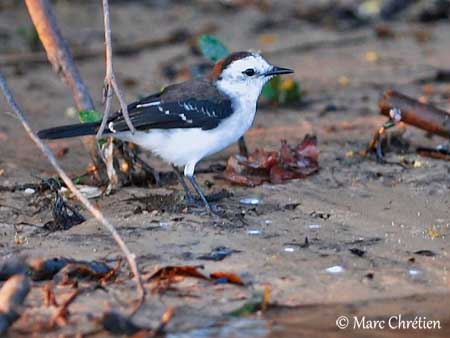
Black-backed Water-tyrant
Fluvicola albiventer
The large ball-shaped nest with side entrance near the top is lined with feathers.
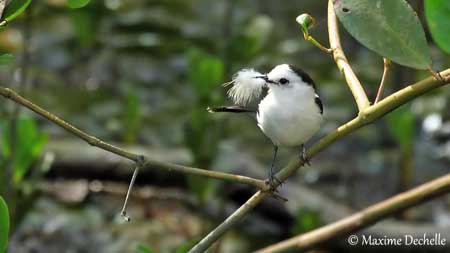
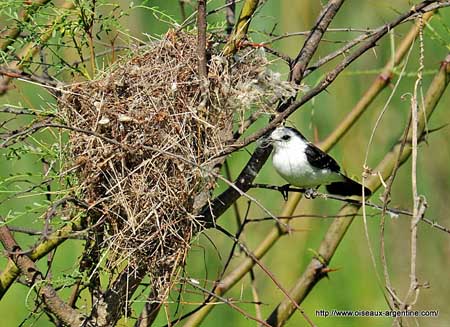
The Masked Water-tyrant (Fluvicola nengeta) is longer-legged and more similar to ground-tyrants of genus Muscisaxicola. There is a widespread population in the open marshes of SE South America, and a local one at W of the Andes, in the coastal area of W Ecuador and N Peru.
This species forages mainly on or near the ground, runs on the floating vegetation and hunts by short aerial sallies and upward strikes.
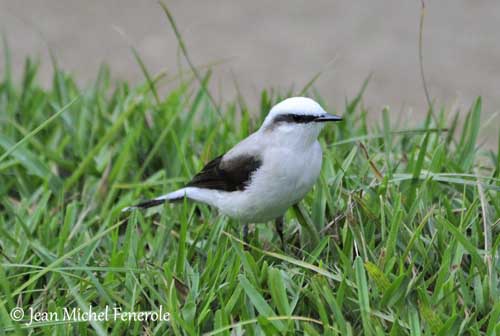
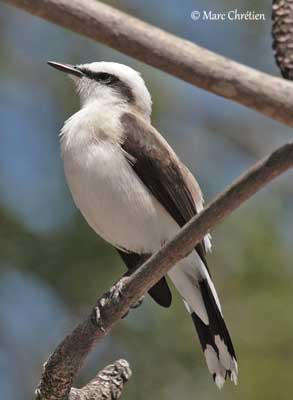
Both species of genus Alectrurus are black and white tyrants living in grassland and marshy habitats. They are related to the previous genera.
They are sexually dimorphic with females showing cryptic brown and white plumage, whereas males are conspicuous and very different from other flycatchers.
They show unusual tail modifications associated with displays, as well when competing for mates and directed at rivals, as in courtship.
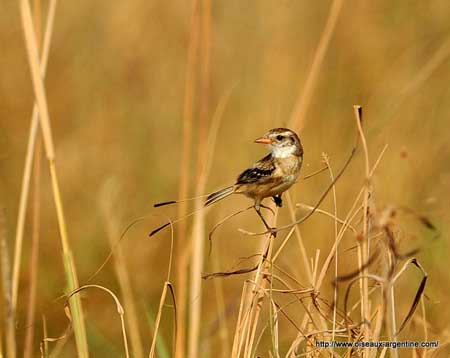
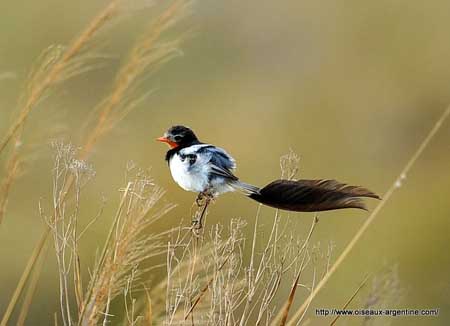
The Cock-tailed Tyrant (Alectrurus tricolor) performs spectacular displays, rising slowly into the air from 5 metres up to 100 metres with fast, fluttering wing-beats, and holding the tail straight down or cocked well above horizontal level. The nest is concealed on or near the ground.
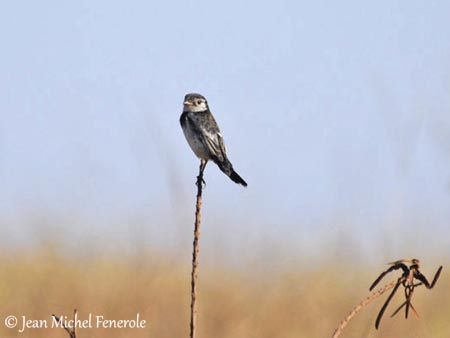
Cock-tailed Tyrant
Alectrurus tricolor
The ground-tyrants of the genus Muscisaxicola are entirely terrestrial. They are long-legged birds, and alternate running and stopping while searching for preys on the ground and in surrounding air areas.
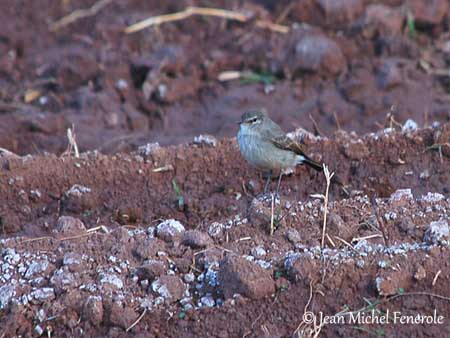
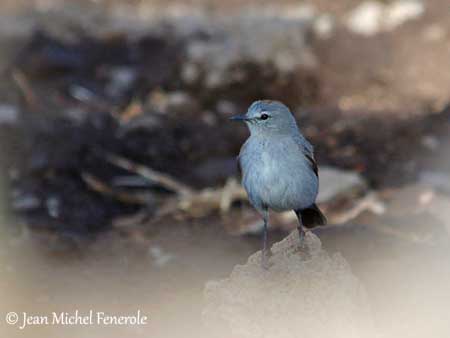
Most of them occur in treeless countryside, but also in barren, rocky terrains. Three species live in Tierra del Fuego, and the southernmost populations perform long-distance migrations.
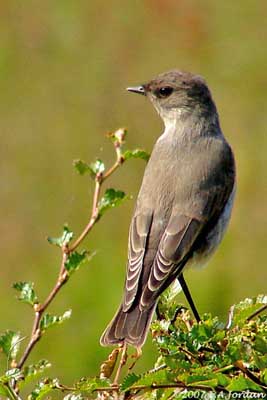
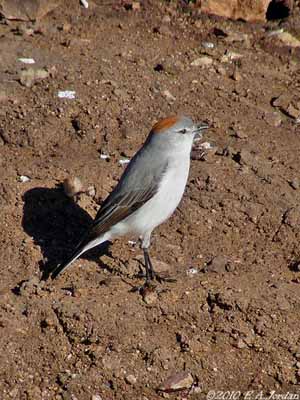
The Little Ground-tyrant (Muscisaxicola fluviatilis) is well established in the Amazon basin. It forages along the muddy and sandy beaches of slow rivers.
The Shrike-tyrants of the genus Agriornis are heavy-bodied with a length of 23-28 centimetres. These big, robust birds have huge, powerful legs. The bill is shrike-like, and conspicuously hooked at the tip.
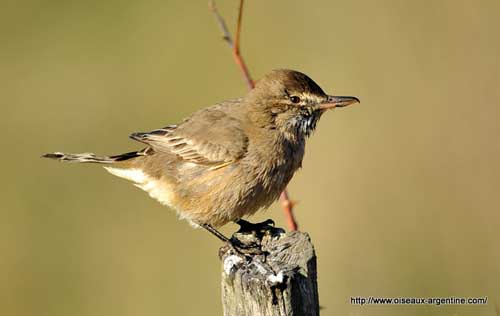
Grey-bellied Shrike-tyrant
Agriornis micropterus
The shrike-tyrants occur mainly in the high Andes. They feed on large terrestrial insects, but they may occasionally take small birds. They usually hunt from high perches.
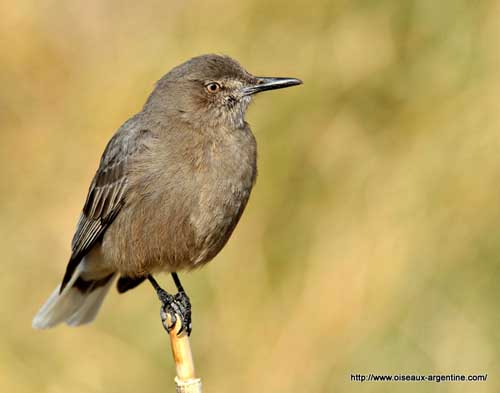
Black-billed Shrike-tyrant
Agriornis montanus
The White-tailed Shrike-tyrant male (Agriornis andicola) performs silent circles during the aerial displays, and alternates rising and dropping on closed wings.
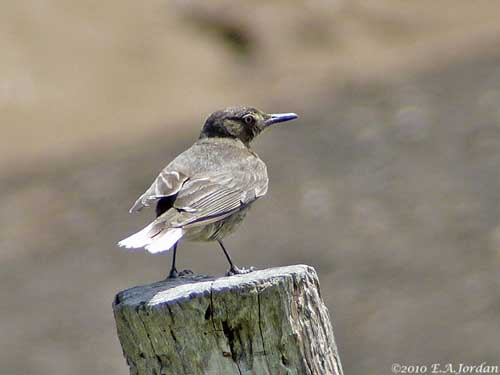
White-tailed Shrike-tyrant
Agriornis andicola
They build a bulky cup-shaped nest with sticks, twigs and grass, with softer lining inside. It is placed on the ground or in low vegetation, in rock crevice or under tile roof.
The four bush-tyrants of the similar genus Myiotheretes are Andean species too. They are found in the upper cloud forest. They hunt by sallies from exposed perches into the air, to vegetation or to the ground for insects.
Both genera Agriornis and Myiotheretes occur in upper-elevation habitats from Venezuela S to Argentina.
Two other bush-tyrants species, each one in monotypic genus, occur well above the tree-line very high in the Andes. They are often found at 4500 metres of elevation, perched on dry rocky cliff faces with scattered vegetation.
The Rufous-webbed Bush-tyrant (Polioxolmis rufipennis) has greyish plumage and bright rufous wing patches. It forages by “hang-gliding” or hovering with spread tail.
The Red-rumped Bush-tyrant (Cnemarchus erythropygius) has white crown and wing patches, and bright rusty tail and underparts. It hunts from perch and sallies to the ground for preys.
The “monjitas” of genus Xolmis are medium-sized to large birds. They occur in open, grassy and bushy areas where they hunt from perches and sally to the ground. Some of them, such as the Rusty-backed Monjita (Xolmis rubetra) are more terrestrial.
Many of them show striking black and white pattern, and especially on the wings.
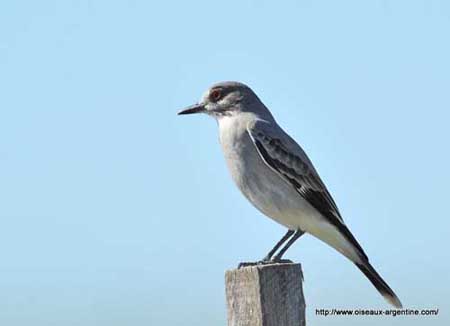
Grey Monjita - Xolmis cinereus
This pattern is highly visible when the bird flies from perch to perch.
The White Monjita (Xolmis irupero) is pure white with black wings. In South America, it is known as “ghost bird” because it often perches atop of gravestones.
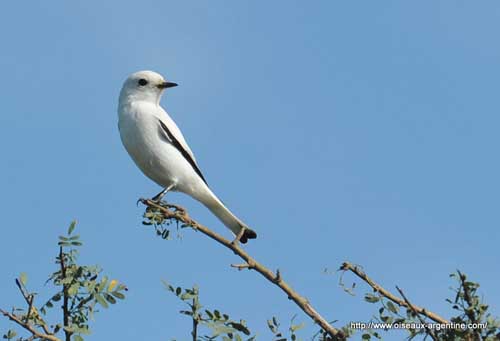
The Fire-eyed Diucon (Now Pyrope pyrope) is different with grey back, whitish underparts and beautiful red eyes. This one hunts more by aerial hawking.
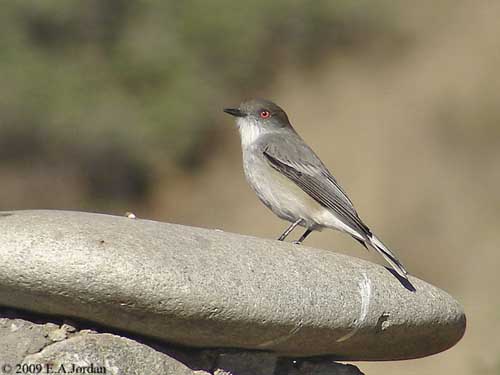
Pyrope pyrope
Xolmis irupero
Four of the Xolmis species range from S Brazil to N Argentina, and often have overlapping distributions. The fifth species, the Black-crowned Monjita (Xolmis coronatus) migrates from S Argentina to these regions.
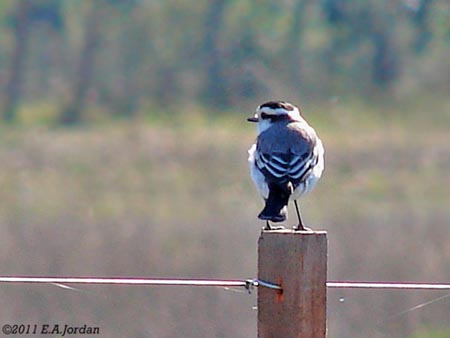
Black-crowned Monjita
Xolmis coronatus
The monjitas are a southern South American radiation, and could be lowland replacements of the closely related Andean genera Agriornis and Myiotheretes.
In southern Brazil and adjacent countries, two monotypic genera, Gubernetes and Muscipipra, include different birds with elongated tail.
Among the most beautiful of Tyrannidae species, the Streamer-tailed Tyrant (Gubernetes yetapa) is a large tyrant of open country. Its large bill allows it to catch very large insects, often on the wing. It also performs sallies to the ground and may take small vertebrates. This bird has a length of about 35-38 centimetres, but up to 42 with the tail.
Both mates engage in duets while performing wing-flapping and tail rising.
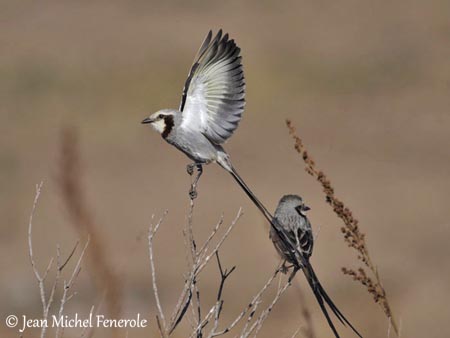
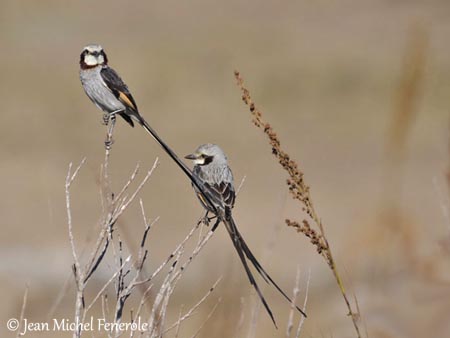
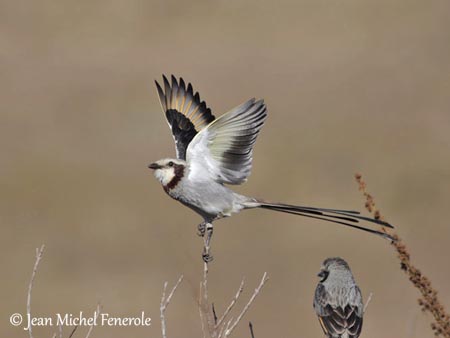
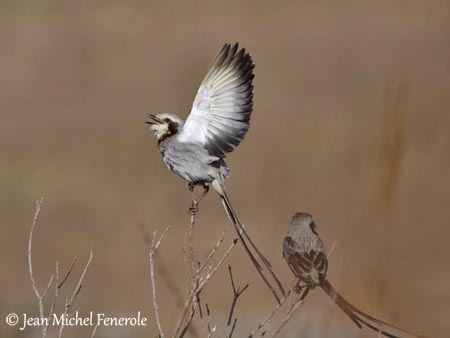
The Shear-tailed Tyrant (Muscipipra vetula) perches at treetops and performs sallies to snatch flying insects.
This species breeds in the high mountains of SE Brazil, but it migrates to spend the austral winter in lowlands where it consumes many fruits.
To complete the subfamily Fluvicolinae and the tribe Fluvicolini, we have three monotypic genera.
The Long-tailed Tyrant (Colonia colonus) is a black-and-white tyrant with elongated central rectrices. Its cavity nesting habits, added to this peculiar physical character, make this bird poorly related to Tyrannidae species.
It forages by aerial hawking, and performs long sallies from high exposed dead tree or leafless tree, and returns to the same perch in lowland forest openings and clearings.
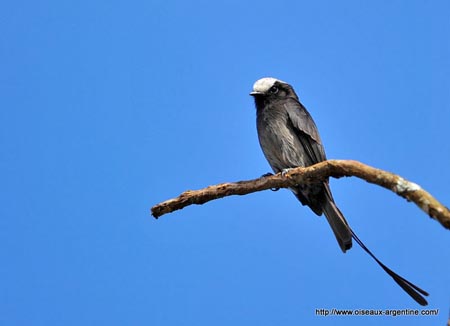
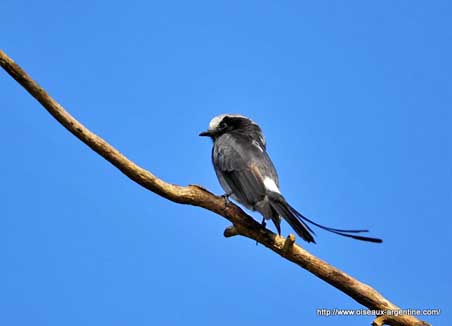
The Short-tailed Field-tyrant (Muscigralla brevicauda) is one of the most terrestrial of all Tyrannidae species. This short-tailed bird has long legs and short, rounded wings.
This genus occurs in the arid coast between SW Ecuador and NW Chile.
The Cattle Tyrant (Machetornis rixosa) is very similar to the yellow-bellied kingbirds of genus Tyrannus. It has even the semi-concealed crown patch.
It forages in open areas and perches high on treetops. It can be seen riding on livestock’s back and often walking along the ground while searching for insects.
It has rounded wings but the primary flight feathers are pointed.
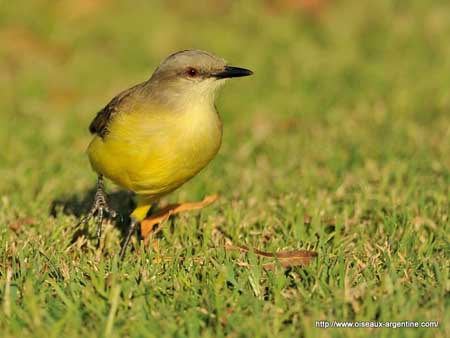
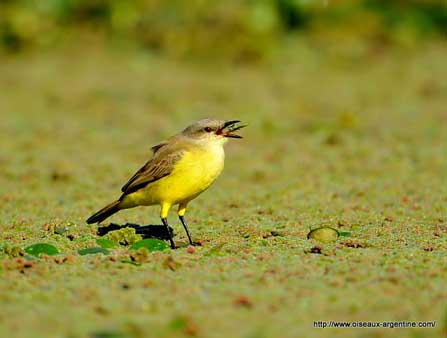
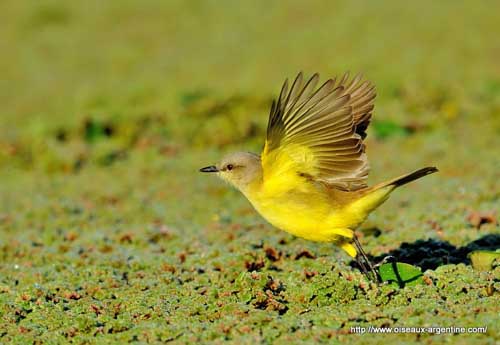
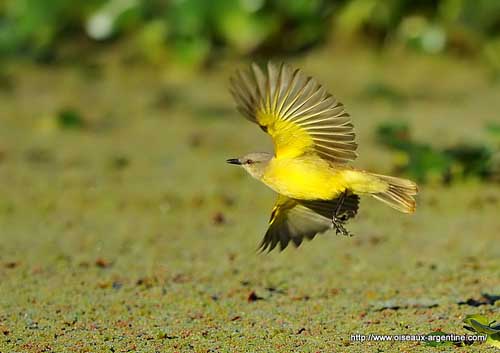
The latest species of the subfamily Fluvicolinae is an excellent transition to the following typical subfamily Tyranninae.
